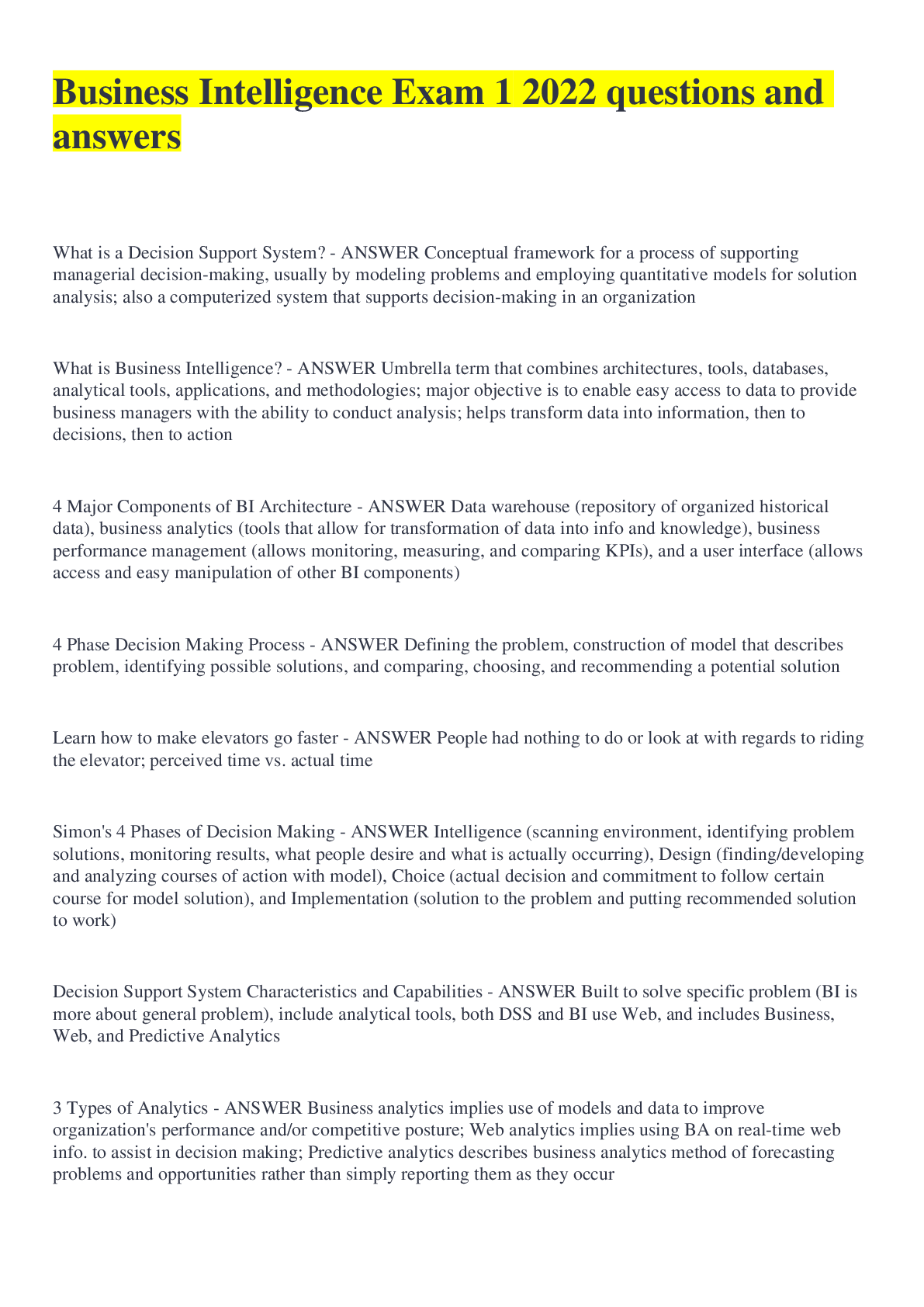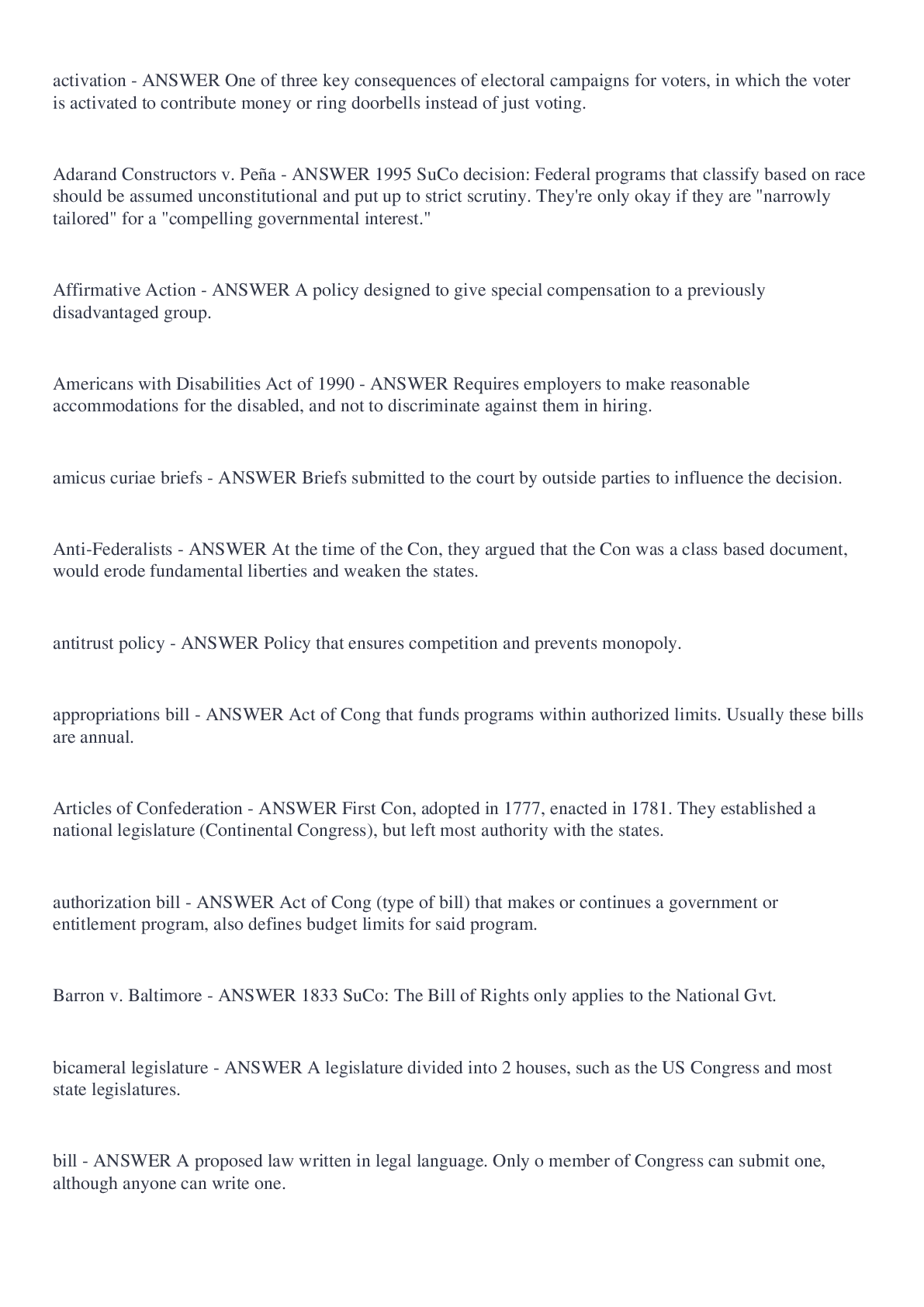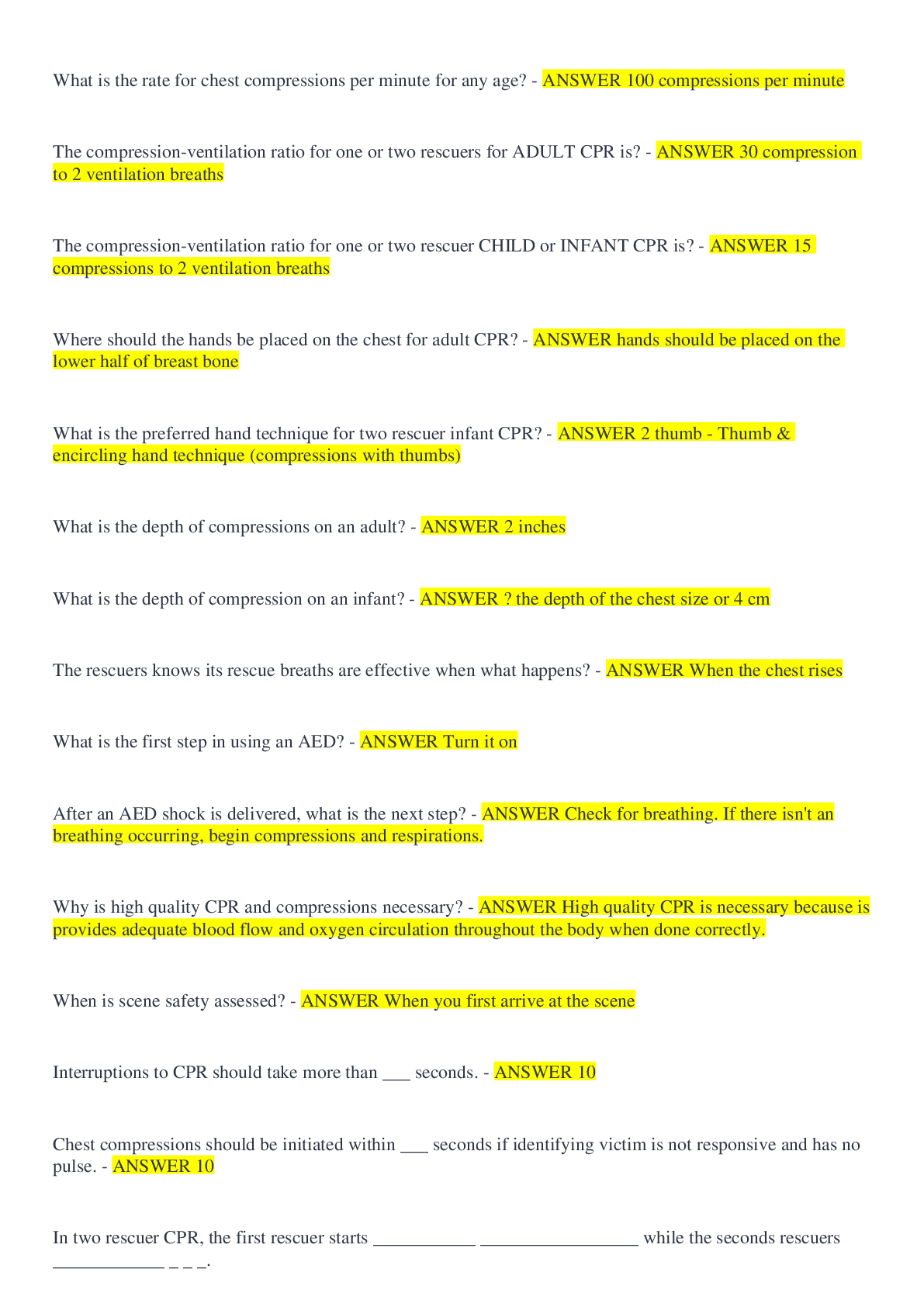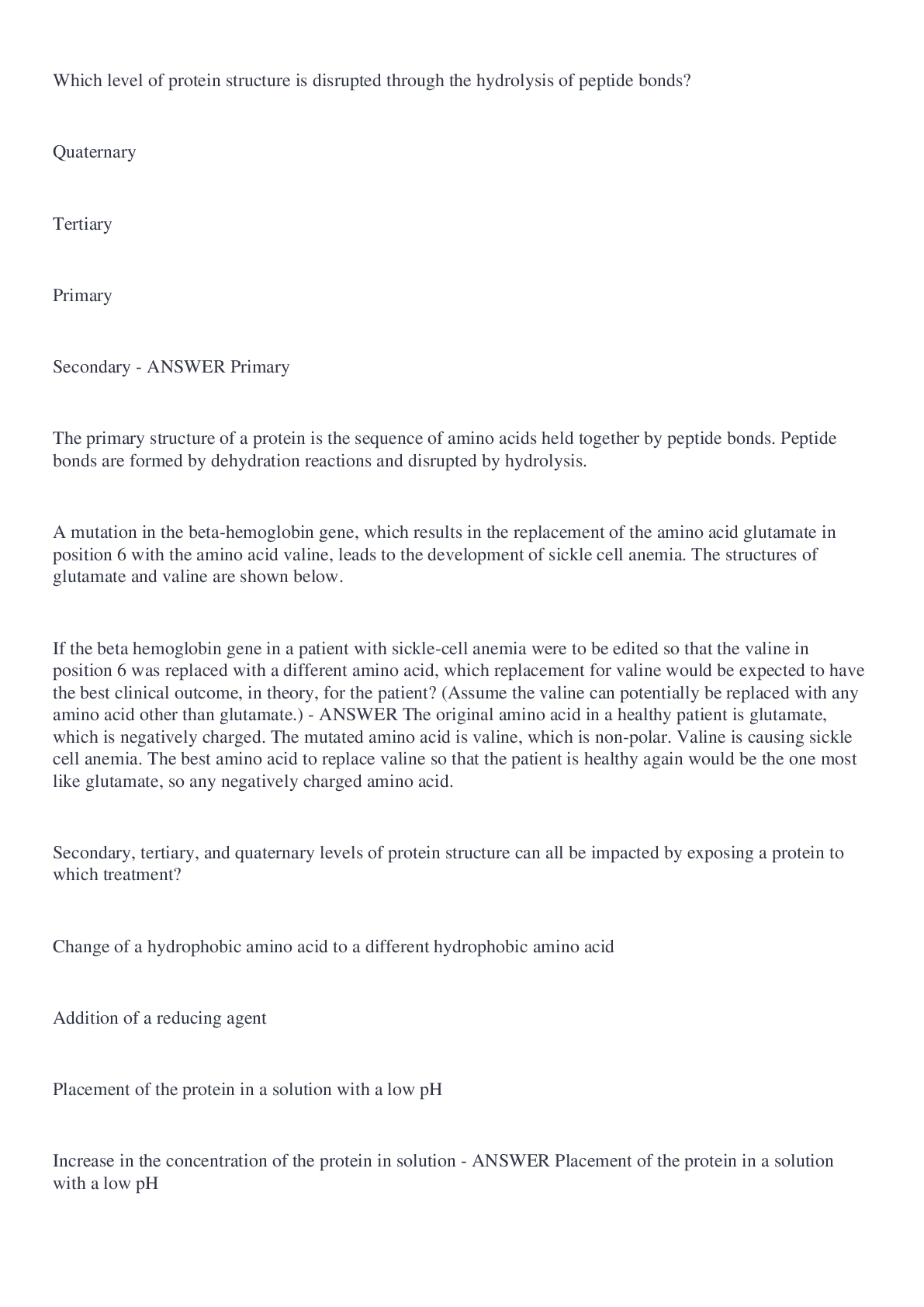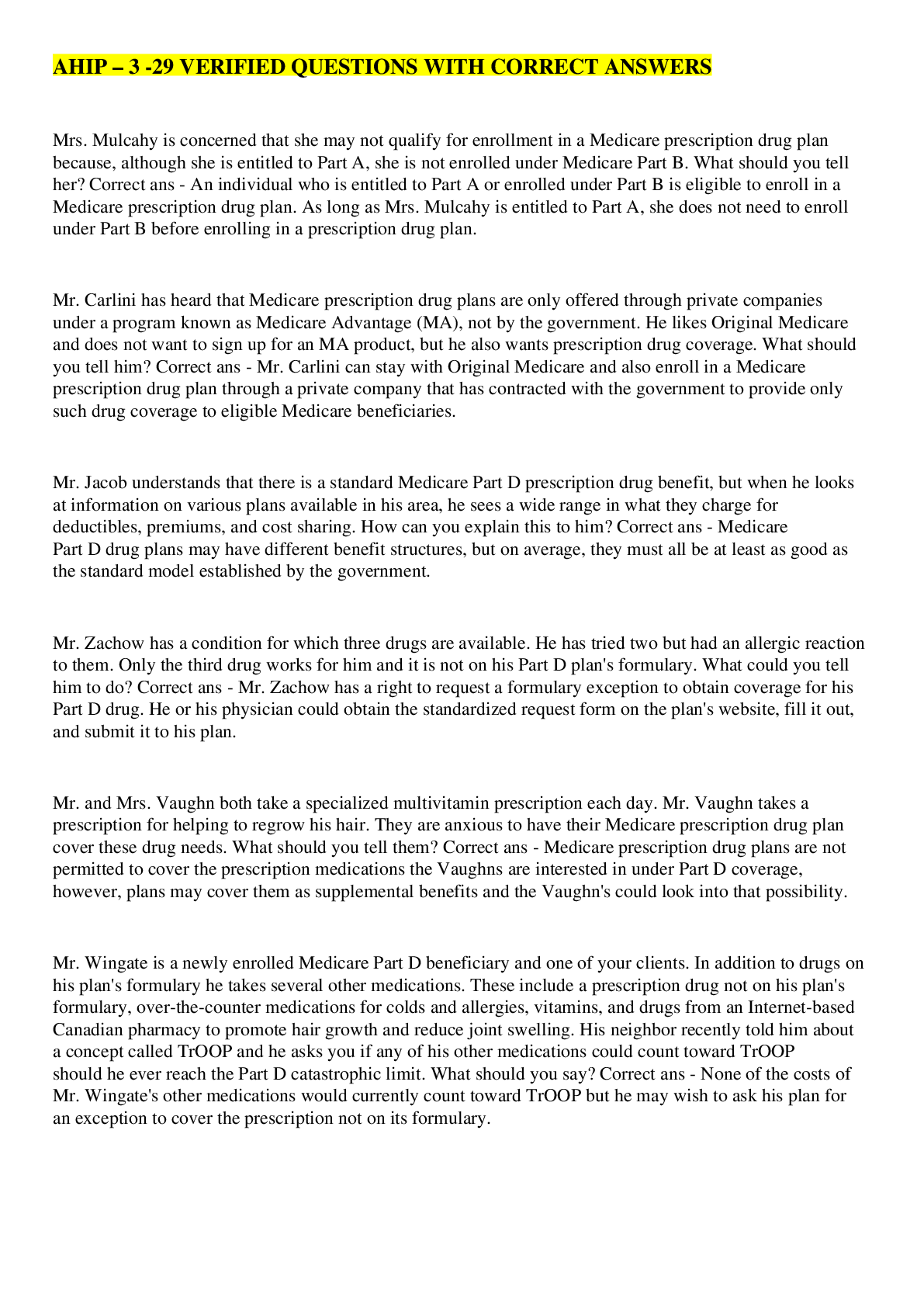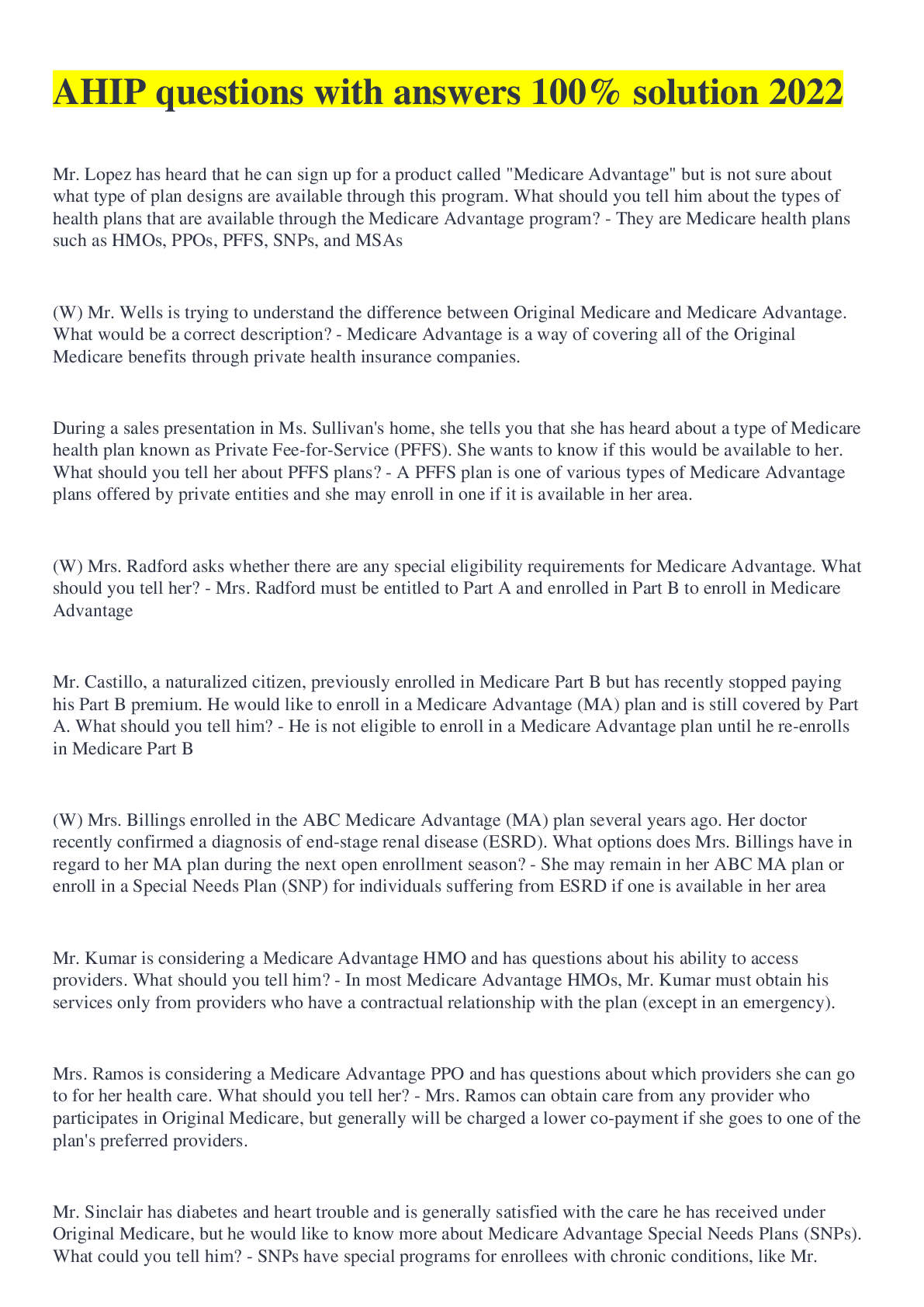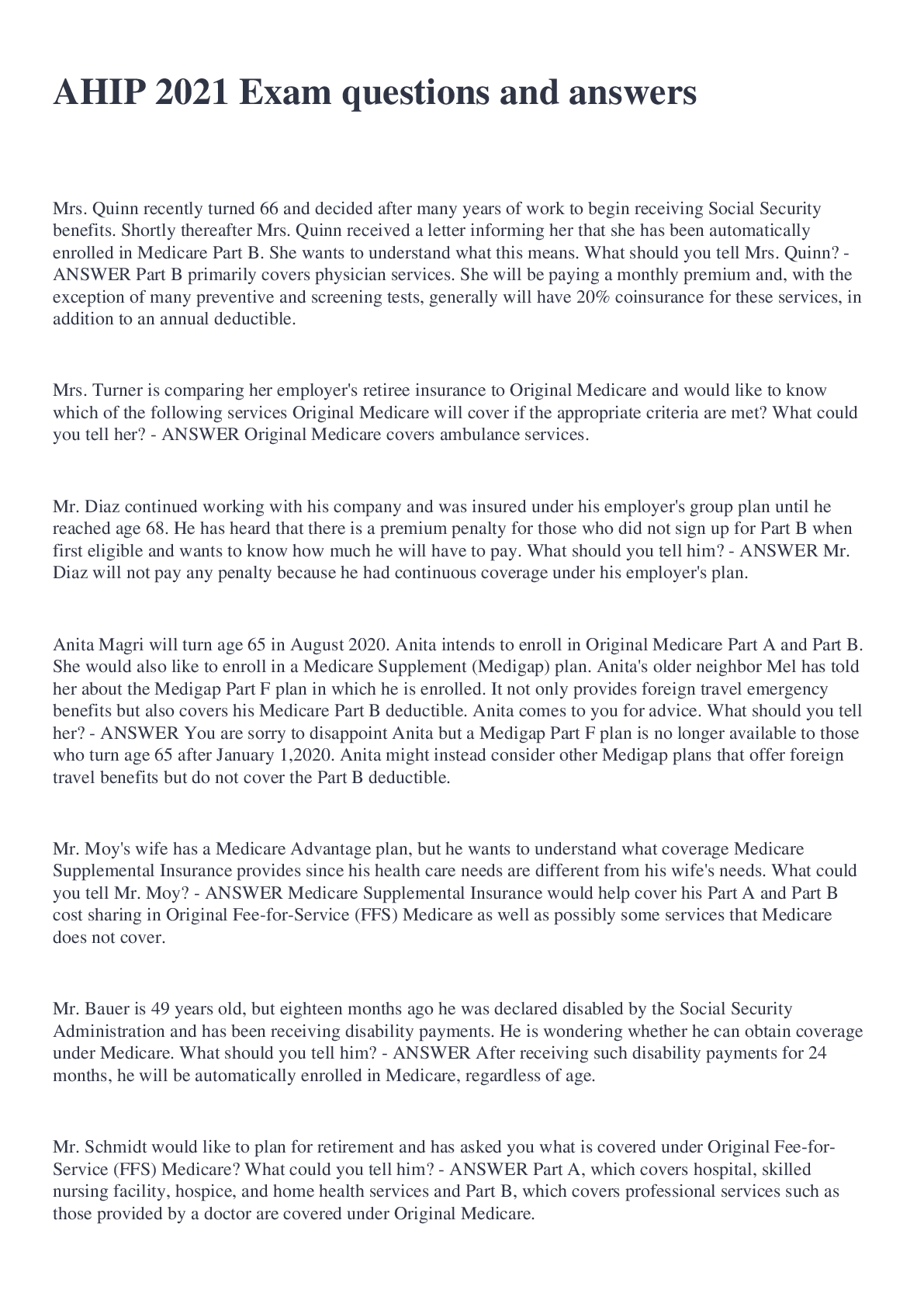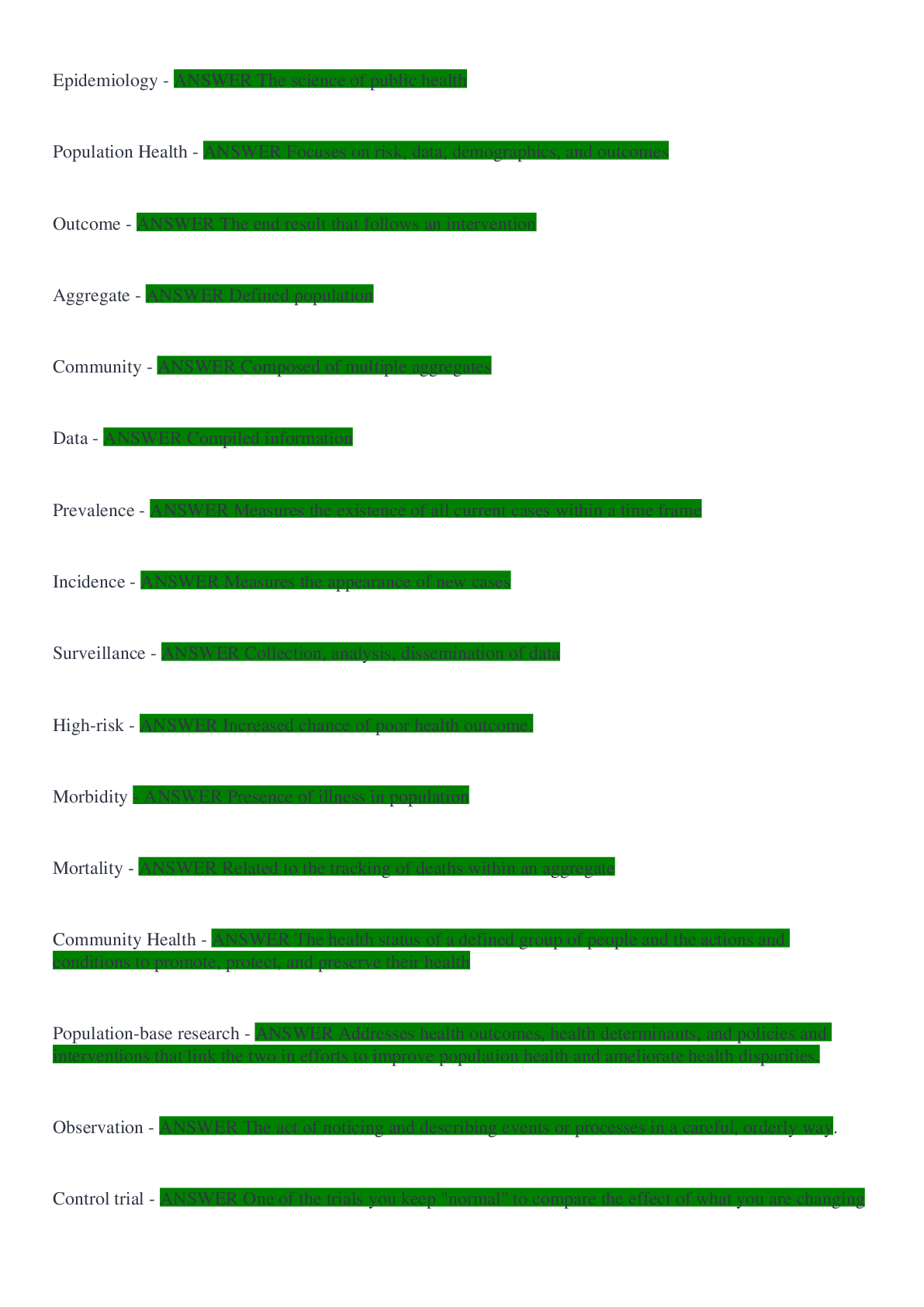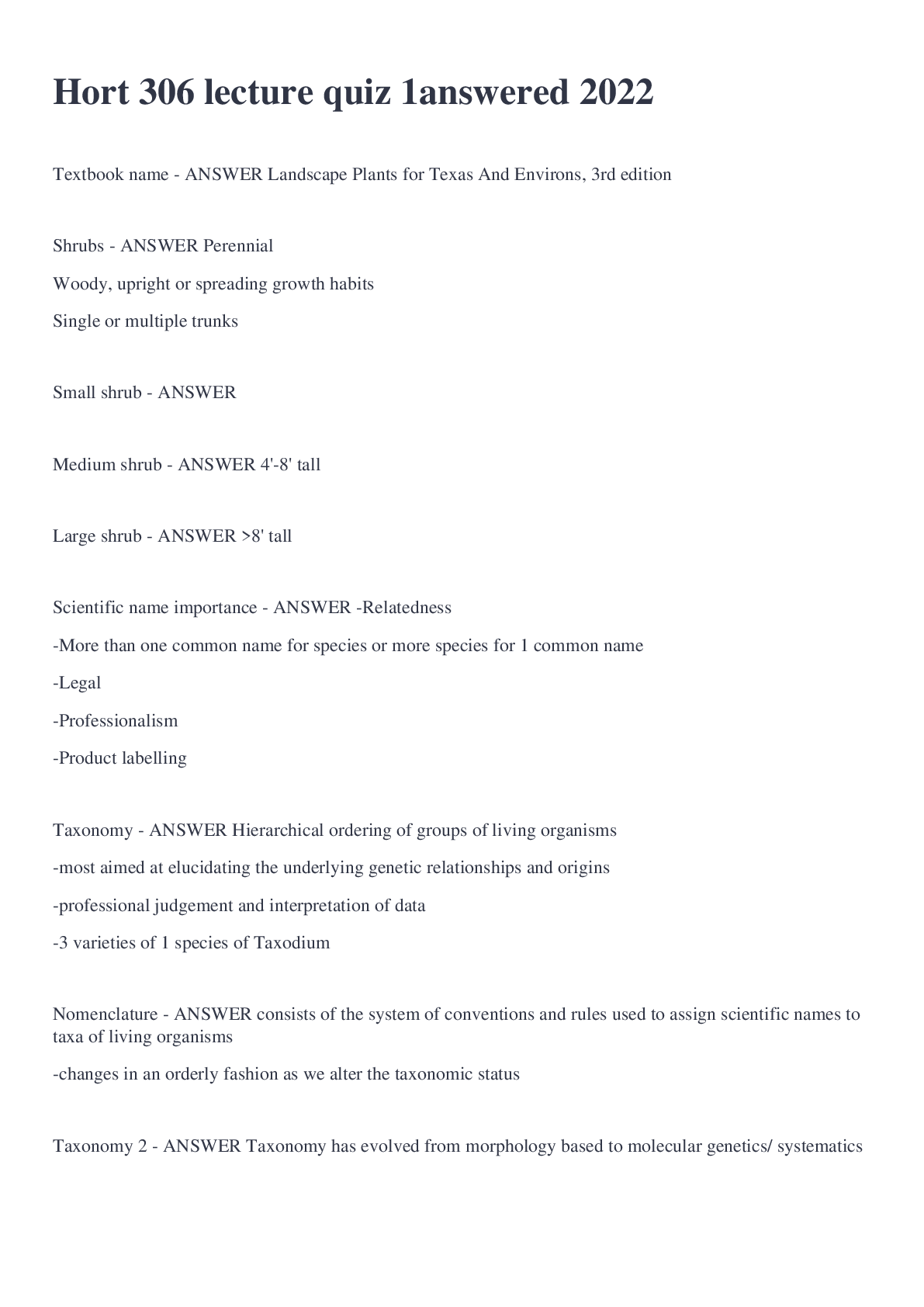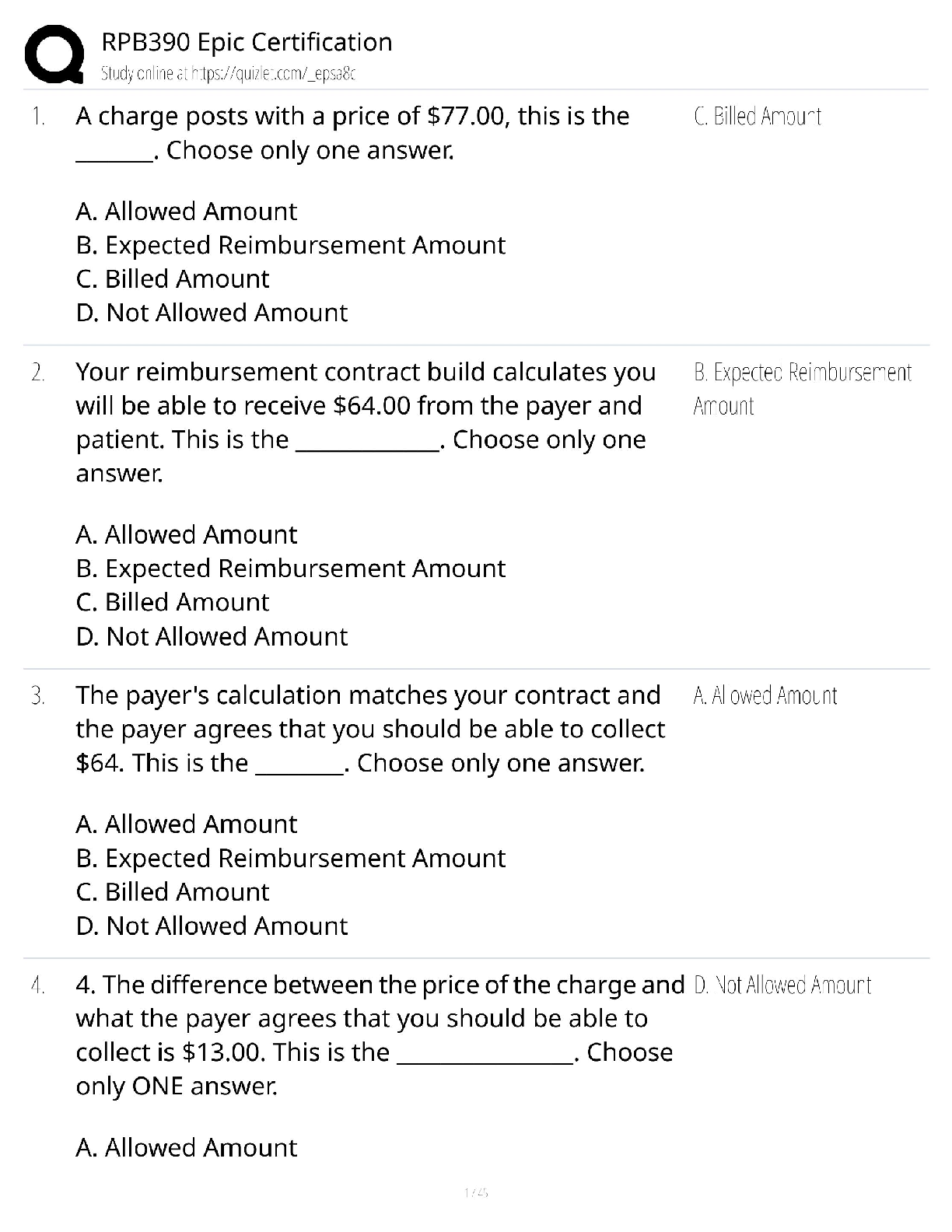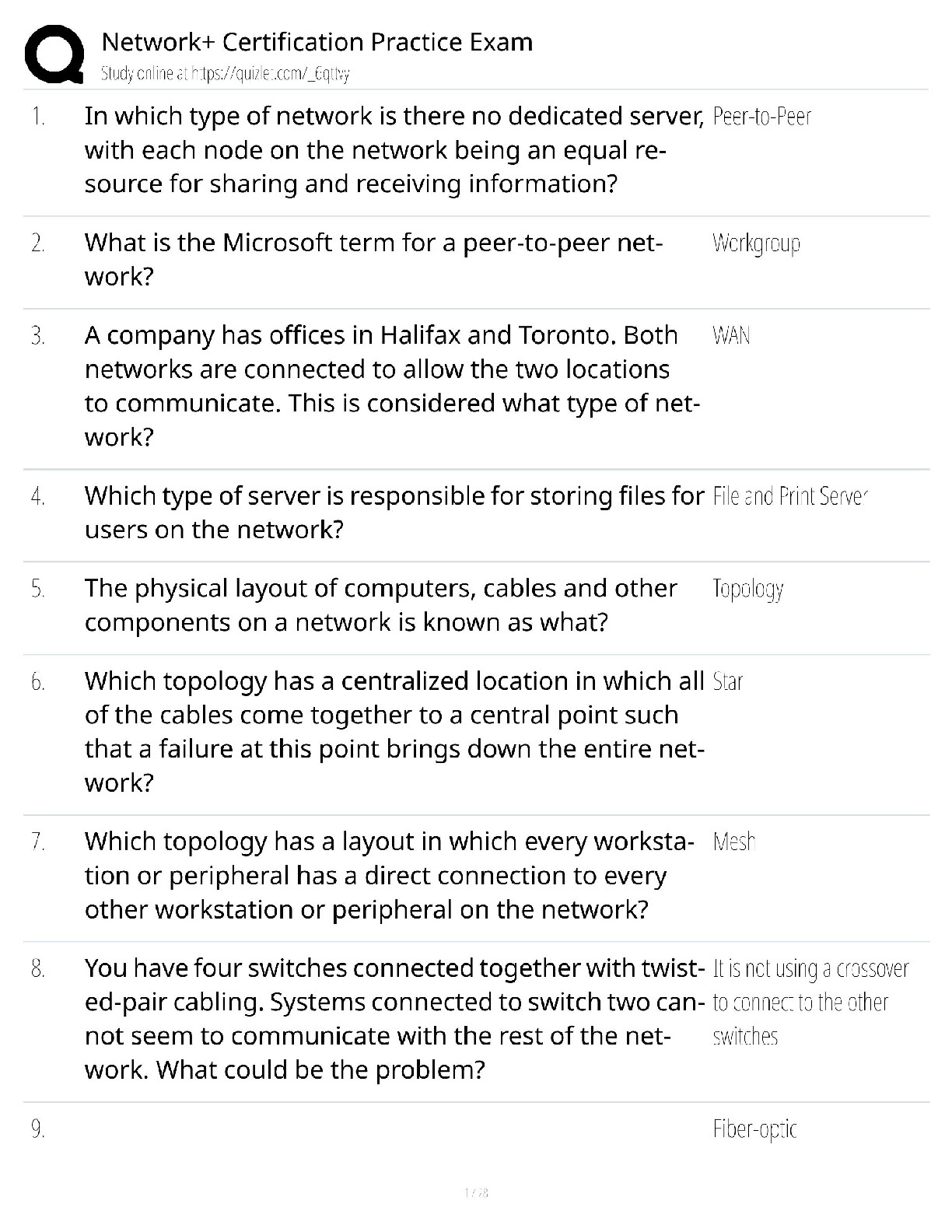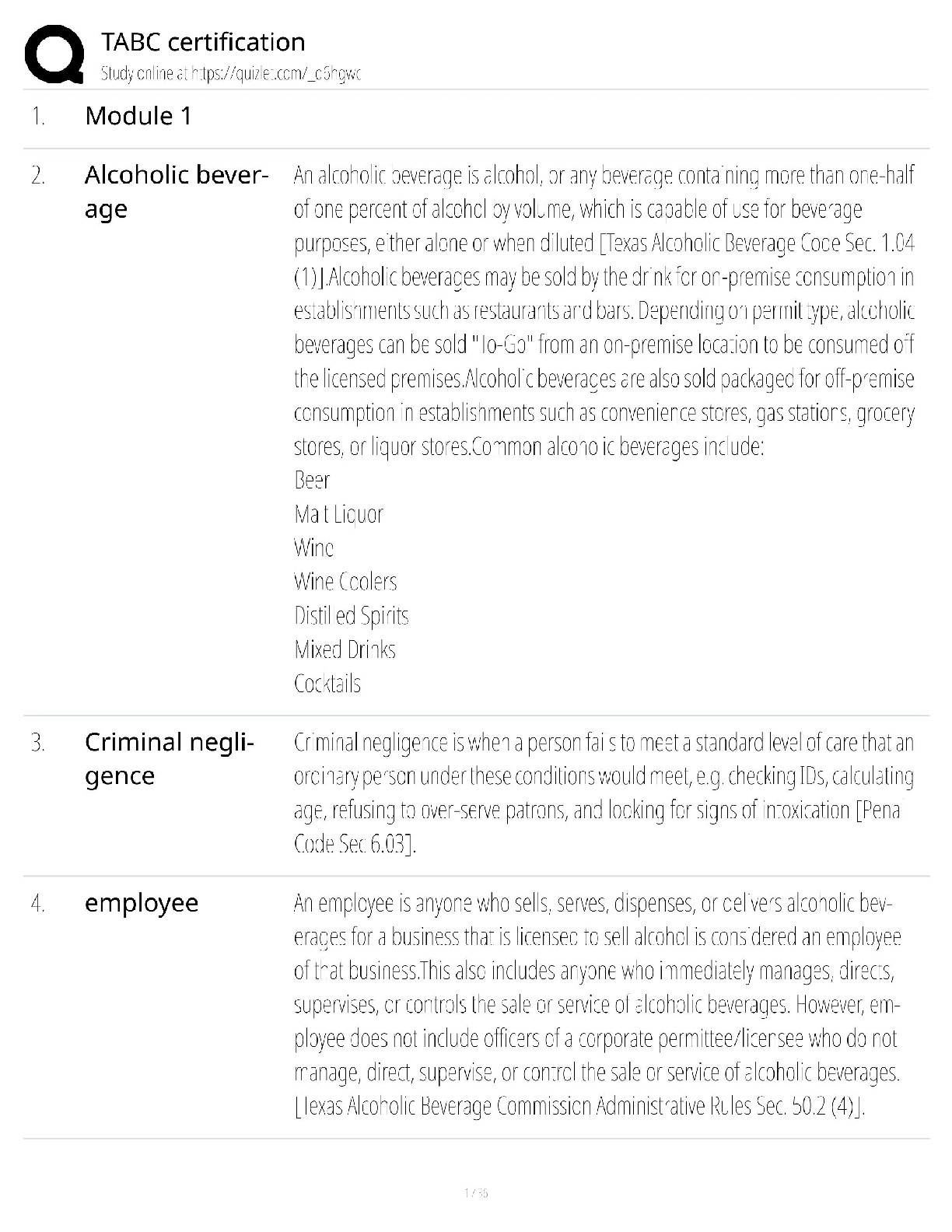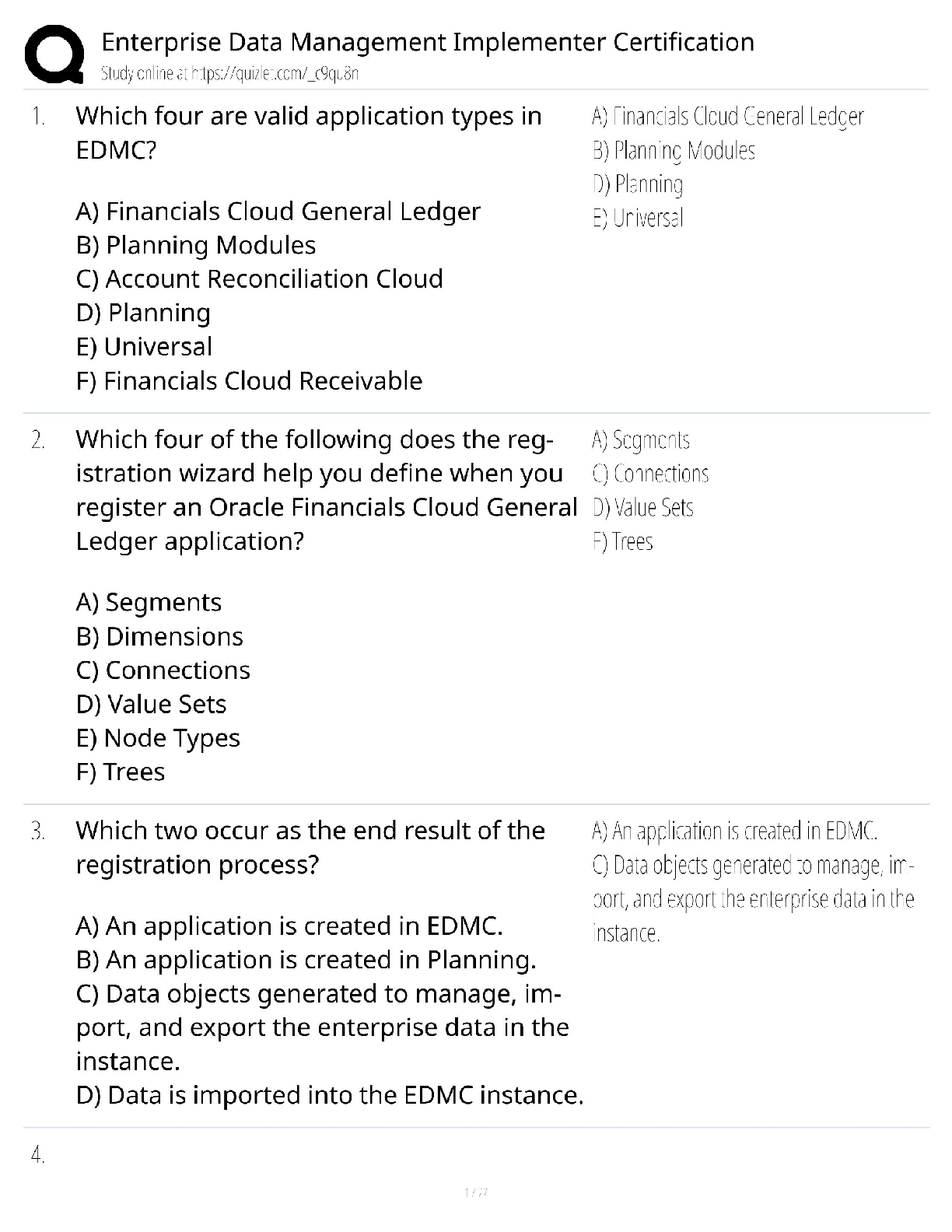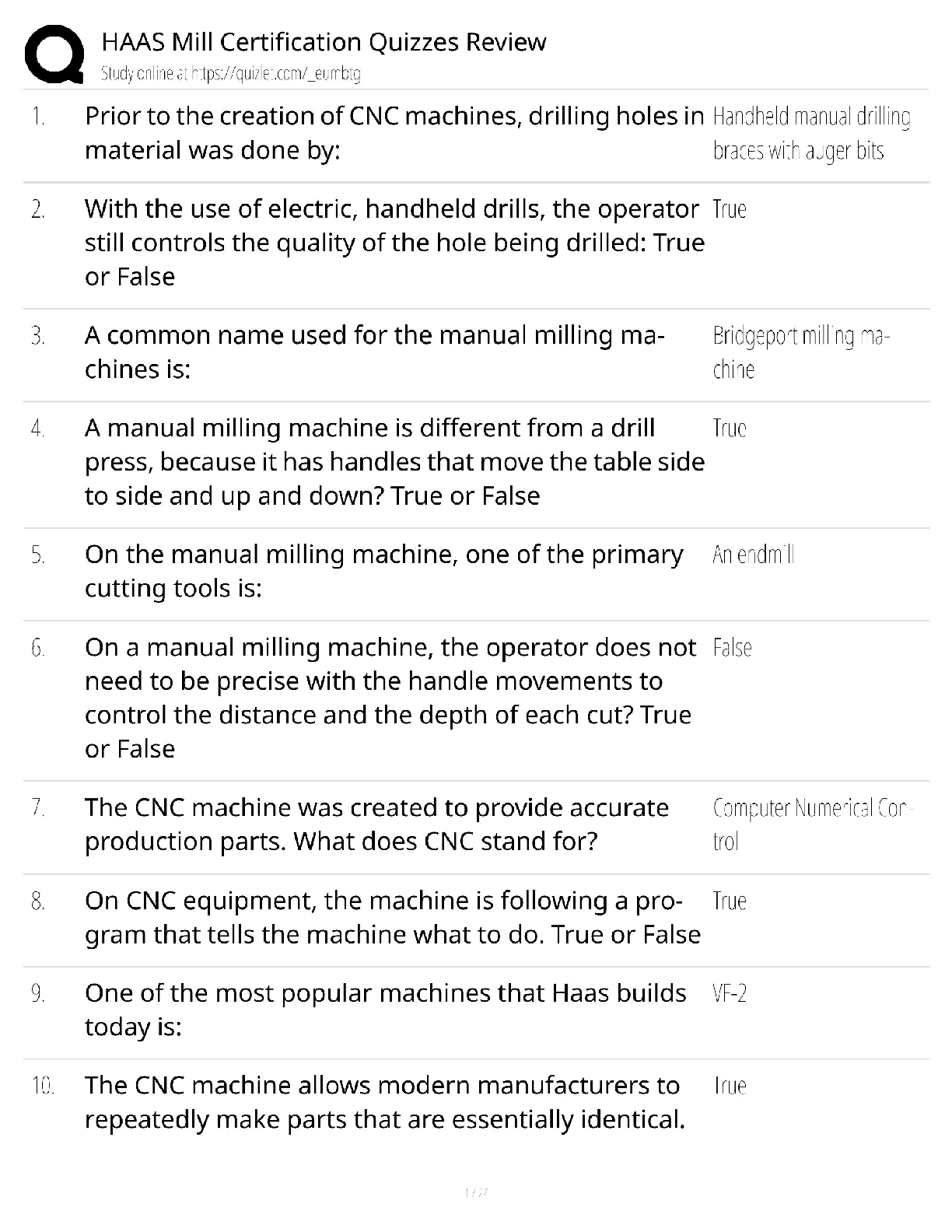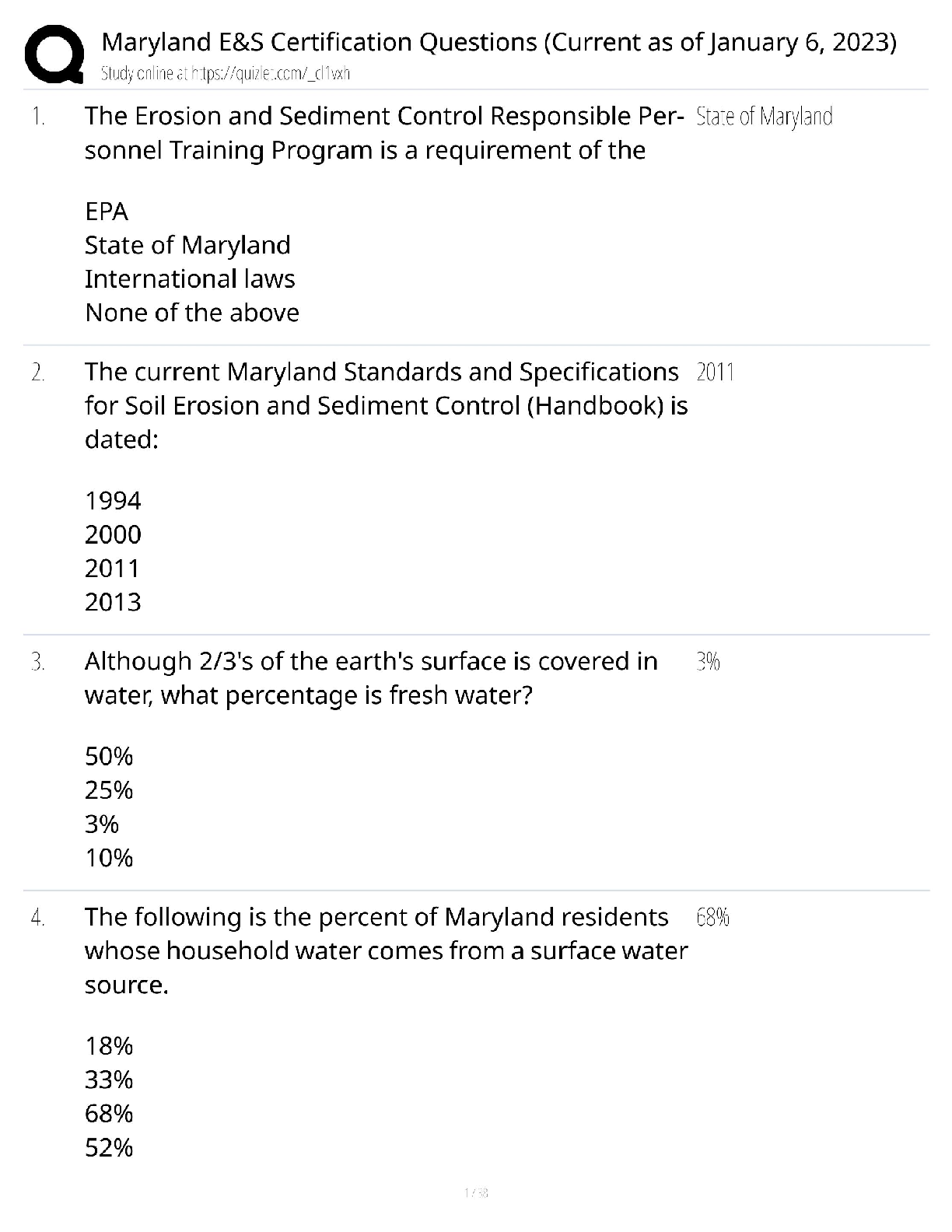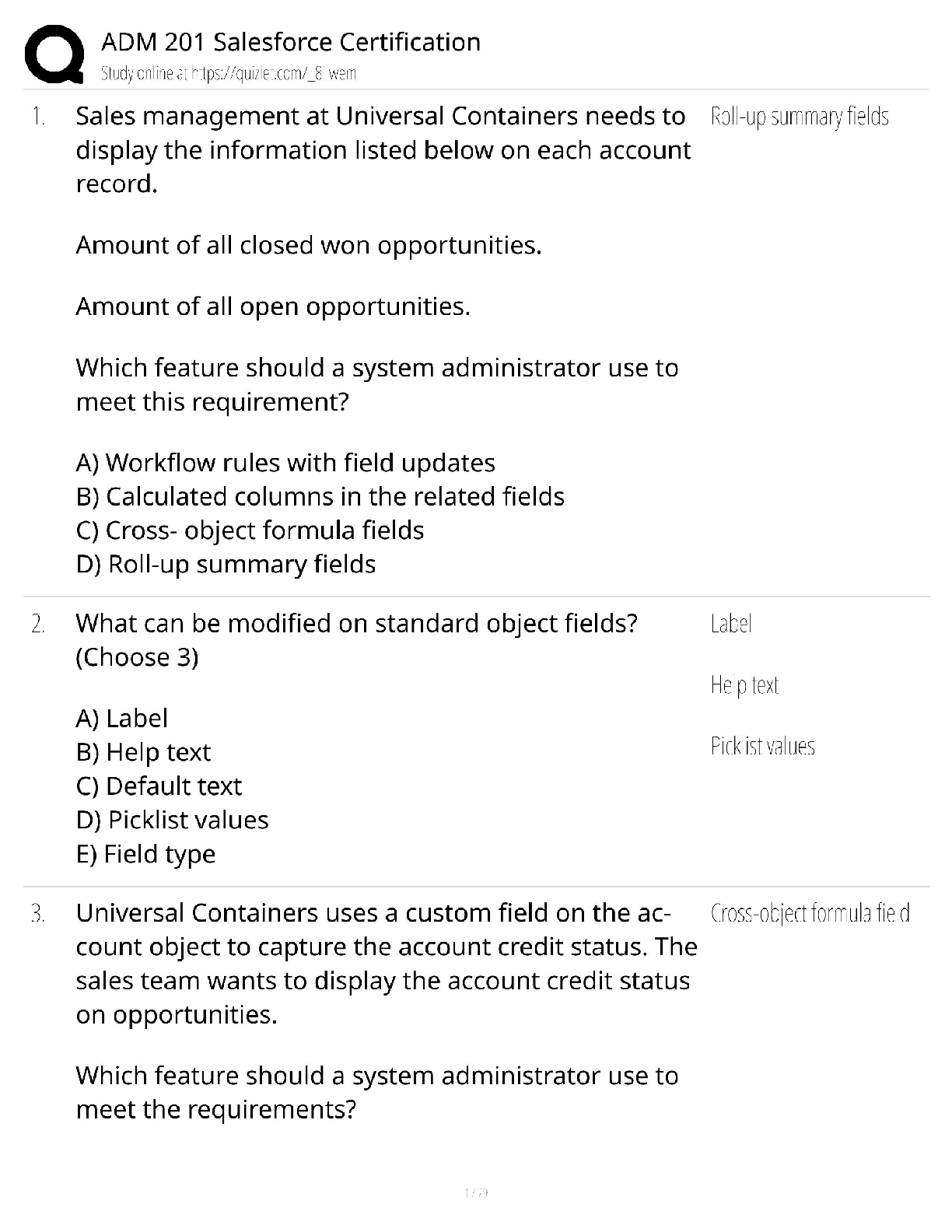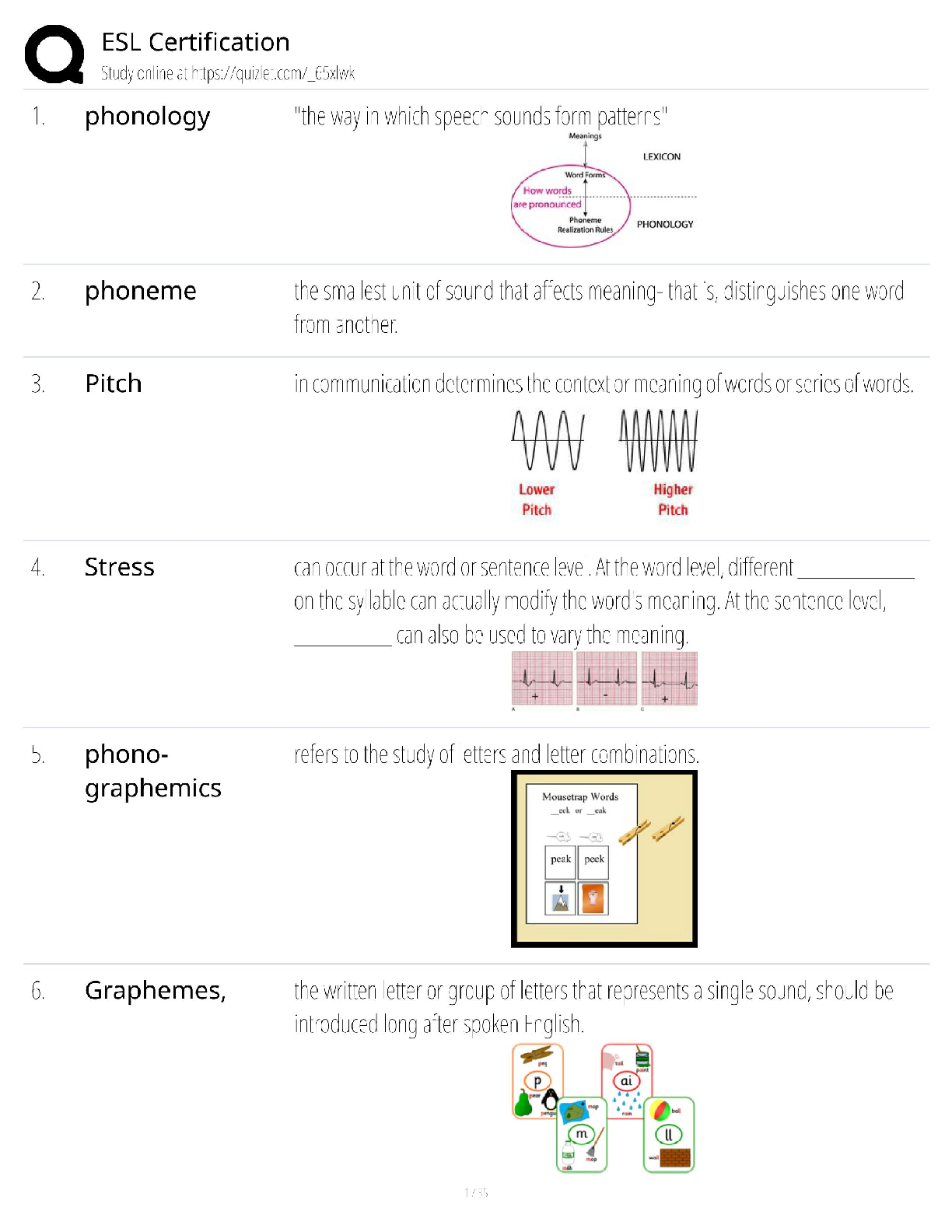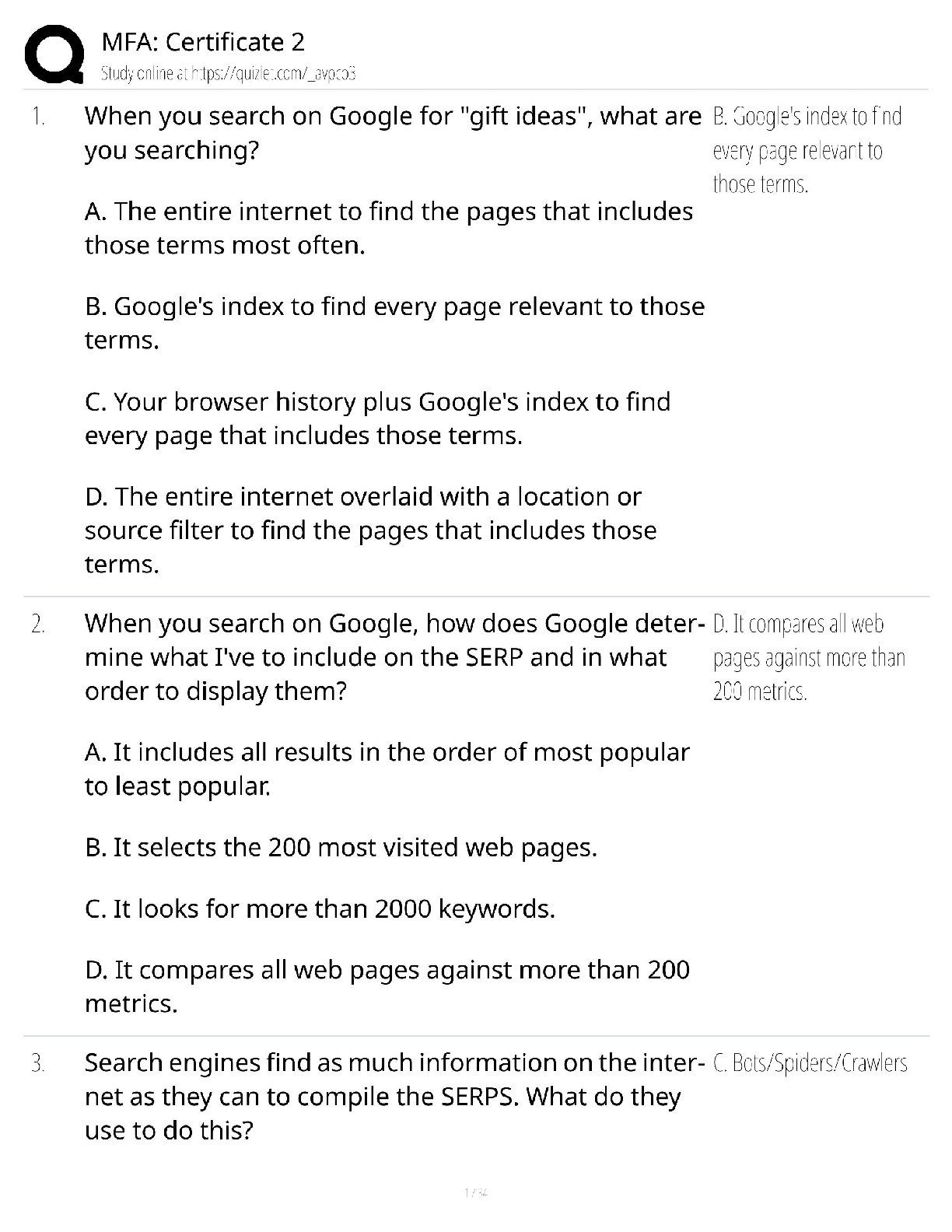Education > QUESTIONS & ANSWERS > ANCC PMHNP BOARD EXAM 2022 Questions and Answers (All)
ANCC PMHNP BOARD EXAM 2022 Questions and Answers
Document Content and Description Below
MOOD D/O: MDD CRITERIA A - ANSWER A. Five (or more) of the following symptoms have been present during the same 2-week period and represent a change from previous functioning; at least one of the sy ... mptoms is either (1) depressed mood or (2) loss of interest or pleasure. Note: Do not include symptoms that are clearly attributable to another medical condition. 1. Depressed mood daily 2. Loss of pleasure of joy in activities/inerests 3. Significant weight loss/gain 4. insomnia/hypersomnia 5. fatigue or loss of energy daily 6. psychomotor retardationagitation 7. feelings of worthlessness or guilt 8. diminished ability to think/concentrate, indecisiveness 9. recurrent thoughts of death, SI, or SI attempt MOOD D/O: MDD CRITERIA B-E - ANSWER B. The symptoms cause clinically significant distress or impairment in social, occupational, or other important areas of functioning. C. The episode is not attributable to the physiological effects of a substance or to another medical condition. D. The occurrence of the major depressive episode is not better explained by schizoaffective disorder, schizophrenia, schizophreniform disorder, delusional disorder, or other specified and unspecified schizophrenia spectrum and other psychotic disorders. E. There has never been a manic episode or a hypomanic episode. Note: This exclusion does not apply if all of the manic-like or hypomanic-like episodes are substance-induced or are attributable to the physiological effects of another medical condition. MOOD D/O: MDD PREVALENCE - ANSWER Twelve-month prevalence of major depressive disorder in the United States is approximately 7%, with marked differences by age group such that the prevalence in 18- to 29-year-old individuals is threefold higher than the prevalence in individuals age 60 years or older. Females experience 1.5- to 3-fold higher rates than males beginning in early adolescence. MOOD D/O: MDD DEVELOPMENT AND COURSE - ANSWER -Recovery typically begins within 3 months of onset for two in five individuals with major depression and within 1 year for four in five individuals. -The risk is higher in individuals whose preceding episode was severe, in younger individuals, and in individuals who have already experienced multiple episodes. -The persistence of even mild depressive symptoms during remission is a powerful predictor of recurrence. MOOD D/O: MDD RISK FACTORS - ANSWER -Neuroticism (negative affectivity) is a well-established risk factor for the onset of major depressive disorder -Adverse childhood experiences, particularly when there are multiple experiences of diverse types, constitute a set of potent risk factors for major depressive disorder. -Stressful life events are well recognized as precipitants of major depressive episodes,but the presence or absence of adverse life events near the onset of episodes does not appear to provide a useful guide to prognosis or treatment selection. -First-degree family members of individuals with major depressive disorder have a risk for major depressive disorder two- to fourfold higher than that of the general population. -Relative risks appear to be higher for early-onset and recurrent forms. Heritability is approximately 40%, and the personality trait neuroticism accounts for a substantial portion of this genetic liability. MOOD D/O: PDD (DYSTHYMIA) DSM5 CRITERIA - ANSWER Depressed mood for most of the day, for more days than not, as indicated by either subjective account or observation by others, for at least 2 years. Note: In children and adolescents, mood can be irritable and duration must be at least 1 year. B. Presence, while depressed, of two (or more) of the following: 1. Poor appetite or overeating. 2. Insomnia or hypersomnia. 3. Low energy or fatigue. 4. Low self-esteem. 5. Poor concentration or difficulty making decisions. 6. Feelings of hopelessness. C. During the 2-year period (1 year for children or adolescents) of the disturbance, the individual has never been without the symptoms in Criteria A and B for more than 2 months at a time. D. Criteria for a major depressive disorder may be continuously present for 2 years. E. There has never been a manic episode or a hypomanic episode, and criteria have never been met for cyclothymic disorder. F. The disturbance is not better explained by a persistent schizoaffective disorder, schizophrenia, delusional disorder, or other specified or unspecified schizophrenia spectrum and other psychotic disorder. G. The symptoms are not attributable to the physiological effects of a substance (e.g., a drug of abuse, a medication) or another medical condition (e.g. hypothyroidism). H. The symptoms cause clinically significant distress or impairment in social, occupational, or other important areas of functioning. Note: Because the criteria for a major depressive episode include four symptoms that are absent from the symptom list for persistent depressive disorder (dysthymia), a very limited number of individuals will have depressive symptoms that have persisted longer than 2 years but will not meet criteria for persistent depressive disorder. If full criteria for a major depressive episode have been met at some point during the current episode of illness, they should be given a diagnosis of major depressive disorder. Otherwise, a diagnosis of other specified depressive disorder or unspecified depressive disorder is warranted. MOOD D/O: DYSTHYMIA PREVALENCE - ANSWER The 12-month prevalence in the United States is approximately 0.5% for persistent depressive disorder and 1.5% for chronic major depressive disorder. MOOD D/O: DYSTHYMIA DEVELOPMENT COURSE - ANSWER Persistent depressive disorder often has an early and insidious onset (i.e., in childhood, adolescence, or early adult life) and, by definition, a chronic course. Among individuals with both persistent depressive disorder and borderline personality disorder, the covariance of the corresponding features over time suggests the operation of a common mechanism. Early onset (i.e., before age 21 years) is associated with a higher likelihood of comorbid personality disorders and substance use disorders. MOOD D/O: DYSTHYMIA RISK FACTORS - ANSWER -Factors predictive of poorer long-term outcome include higher levels of neuroticism (negative affectivity), greater symptom severity, poorer global functioning, and presence of anxiety disorders or conduct disorder. -It is thus likely that individuals with persistent depressive disorder will have a higher proportion of first-degree relatives with persistent depressive disorder than do individuals with major depressive disorder, and more depressive disorders in general. -A number of brain regions (e.g., prefrontal cortex, anterior cingulate, amygdala, hippocampus) have been implicated in persistent depressive disorder. Possible polysomnographic abnormalities exist as well. CN I - ANSWER olfactory-smell sensory CN II - ANSWER Optic - vision sensory CN III - ANSWER Oculomotor Nerve- Motor Controls eye movement, pupil constriction, & eyelid movement CN IV - ANSWER trochlear nerve-down and inward eye movement motor CN V - ANSWER trigeminal nerve-muscles of mastication; sensation of face, scalp cornea, mucus membranes and nose -assess the face for strength and sensation sensory and motor CN VI - ANSWER abducens nerve-lateral eye movement motor CN VII - ANSWER facial nerve-move face, close mouth and eyes, taste, saliva and tear secretion -assess mouth for taste -assess the face for symmetrical movement sensory and motor CN VIII - ANSWER acoustic sensory: hearing and equilibrium CN IX - ANSWER glossopharyngeal-PHONATION, GAG REFLEX CAROTID REFLEX SWALLOWING TASTE -assess mouth for taste -assess mouth for movement of soft palate and the gag reflex -assess swallowing and speech sensory and motor CN X - ANSWER vagus-TALKING, SWALLOWING, GENERAL SENSATION FROM THE CAROTID BODY, CAROTID REFLEX -assess mouth for movement of soft palate and the gag reflex -assess swallowing and speech sensory and motor CN XI - ANSWER spinal accessory-movement of trapezius and sternomastoid muscles -assess the shoulders for strength motor CN XII - ANSWER hypoglossal-tongue movement motor UDS alcohol detection period - ANSWER 7-12 hrs UDS amphetamine detection period - ANSWER 24-48 hrs UDS barbiturates detection period - ANSWER 24 hrs: short acting 3 weeks UDS benzos - ANSWER 3 days or wks w/ heavy use UDS cannabis - ANSWER 3 days to 4 wks: depends on use UDS cocaine - ANSWER 6-8 hrs; metabolites 2 to 4 days UDS heroin - ANSWER 36-72 hrs UDS methadone - ANSWER 3 days UDS Methaqualone m*f* quaaludes!!!!! - ANSWER 7 days UDS Morphine - ANSWER 46-72 HRS UDS - PCP - ANSWER 8 days **CPK & AST often elevated** UDS Propoxyphene - ANSWER 6-48 hrs CHILDREN: routine checkups - ANSWER Start: 1 to 2 weeks How often: every month x 4, 6, 9, 12, 15, 18, 24 mo, annually after 3 yrs CHILDREN: anemia - ANSWER 9-12 mo, as needed CHILDREN: blood test for lead - ANSWER 9 to 12 mo, annually after if in high risk area CHILDREN: UA - ANSWER age 5, as needed CHILDREN: BP - ANSWER age 3, annually CHILDREN: hearing and vision - ANSWER start:prior to discharge or 1 mo, prior to discharge and by 6 mo how often: annually at age 4/3, screen for strabismus btwn 3 and 5 Tanner Stage 1 (boys and girls) - ANSWER Boys: preadolescent testes, scrotum, penis Girls: preadolescent breasts Pubic hair: Preadolescent Tanner Stage 2 (boys and girls) - ANSWER Boys: Enlargement of scrotum, testes; scrotum roughens and reddens Girls: Breast buds w/ areolar enlargement Pubic hair: Sparse, pale, fine Tanner Stage 3 (boys and girls) - ANSWER Boys: Penis elongates Girls: Breast enlargement without separate nipple contour Pubic hair: Darker, increased amount, curlier Tanner Stage 4 (boys and girls) - ANSWER Boys: Penis enlarges in breadth and development of glans; rugae appear Girls: Areola and nipple project as secondary mound Pubic hair: Adult in character but not as voluminous Tanner Stage 5 (Boys and girls) - ANSWER Boys: Adult shape and appearance Girls: Adult breast; areola recedes, nipple retracts Pubic hair: Adult pattern Trust vs. Mistrust - ANSWER Erikson: 0-18 mo: If needs are dependably met, infants develop a sense of basic trust Failure: Difficult receiving and giving Autonomy vs. Shame and Doubt - ANSWER Erikson: 18 mo-3 yrs: Erikson's stage in which a toddler learns to exercise will and to do things independently; Goal: self-control, will power, control of body Failure: lack of self-confidence and rage against ones' self Initiative vs. Guilt - ANSWER Erikson: 3-6 yrs: Goal: to identify and direct his/her activities Failure: feelings of inadequacy and guilt Industry vs. Inferiority - ANSWER Erikson: 6-12 y.o. (school age): Goal: Self-confidence and peer recognition Failure: Low self-esteem and poor interpersonal relations identity vs. role confusion - ANSWER Erikson's stage during which teenagers and young adults search for and become their true selves 12-20 y.o. Failure: Lack of direction and confidence in self schema (Piaget's theory of cognitive development) - ANSWER A mental structure of patterns and thinking assimilation (Piaget) - ANSWER Incorporating new information into current schemas according to new environmental stimuli perceived Accommodation (Piaget) - ANSWER adjusting to new information by creating new schemas Equilibrium (Piaget's Theory) - ANSWER symbiosis of sensory information and accumulated knowledge Equilibration (Piaget) - ANSWER search for mental balance between cognitive schemes and information from the environment sensorimotor stage (Piaget) - ANSWER 0-2 yrs 1. reflexive movements 2.understanding of action and result 3. differentiate self from other objects 4. hold mental image preoperational stage (Piaget) - ANSWER 2-7 yrs 1. Symbolic play and understanding 2. Only in present-no clear understanding of time 3. non-contested respect for authority 4. cannot distinguish real from fantasy Concrete Operational stage (Piaget) - ANSWER 7-12 years Understanding of concrete relationships (math and quantity); development of conservation (knowing changes in shape are not changes in volume), spacial relationships, think about past and present, begins to value others Formal Operational stage (Piaget) - ANSWER 11-15+ y.o. 1. Future thinking 2. Abstract thinking 3. Complex problem solving Reflex: rooting and sucking - ANSWER Appears: Newborn Disappears: 3-4 mo Reflex: Moro (startle) - ANSWER Appears: Newborn Disappears: 3-4 mo Elicit by striking a flat surface while infant is lying or allow head and trunk to fall backward to an angle of 30. Reaction: infants arms and legs symmetrically extend and then abduct while her fingers spread to form a C shape. Grasp (palmar, plantar) reflex - ANSWER Appears: Newborn Disappears: 3-6 mo; 4 mo Pacing/stepping reflex - ANSWER appears: Newborn disappears 1-2mo Hold baby upright w/hand across chest - baby steps Tonic neck reflex (fencer position) - ANSWER BIRTH TO 3 or 4 MONTHS Turn newborn head turned to the right: Right arm/leg EXTEND Left arm/leg flex Turn newborn head to the left: Left arm/leg EXTEND Right arm/leg flex Babinski reflex - ANSWER Appears: Newborn Disappears: 12 mo or when walking Reflex in which a newborn fans out the toes when the sole of the foot is touched cerebral cortex (cerebrum) - ANSWER -grey, wrinkled surface that is densely packed with neurons -located in upper forebrain -connections between neurons grow as we learn and develop -surface is wrinkled to increase surface area (convolutions) -2 hemispheres right hemisphere functions - ANSWER -Receives somatic sensory signals from and controls muscles on left side of body. -Musical and artistic awareness -Space and pattern perception -Recognition of faces and emotional content of facial expressions -Generating emotional (negative) content of language -Generating mental images to compare spatial relationships -processes interacting w/ the environment -attention capacity -intuition -Identifying and discriminating among odors left hemisphere functions - ANSWER -sequential processing, analytic thought, logic, language, science and math -positive emotions Microsystem - ANSWER direct patient care Macrosystem - ANSWER hospitals, skilled nursing facilities, clinics megasystem - ANSWER American Healthcare system Metasystem - ANSWER economic, political, social level of society [Show More]
Last updated: 3 years ago
Preview 1 out of 24 pages
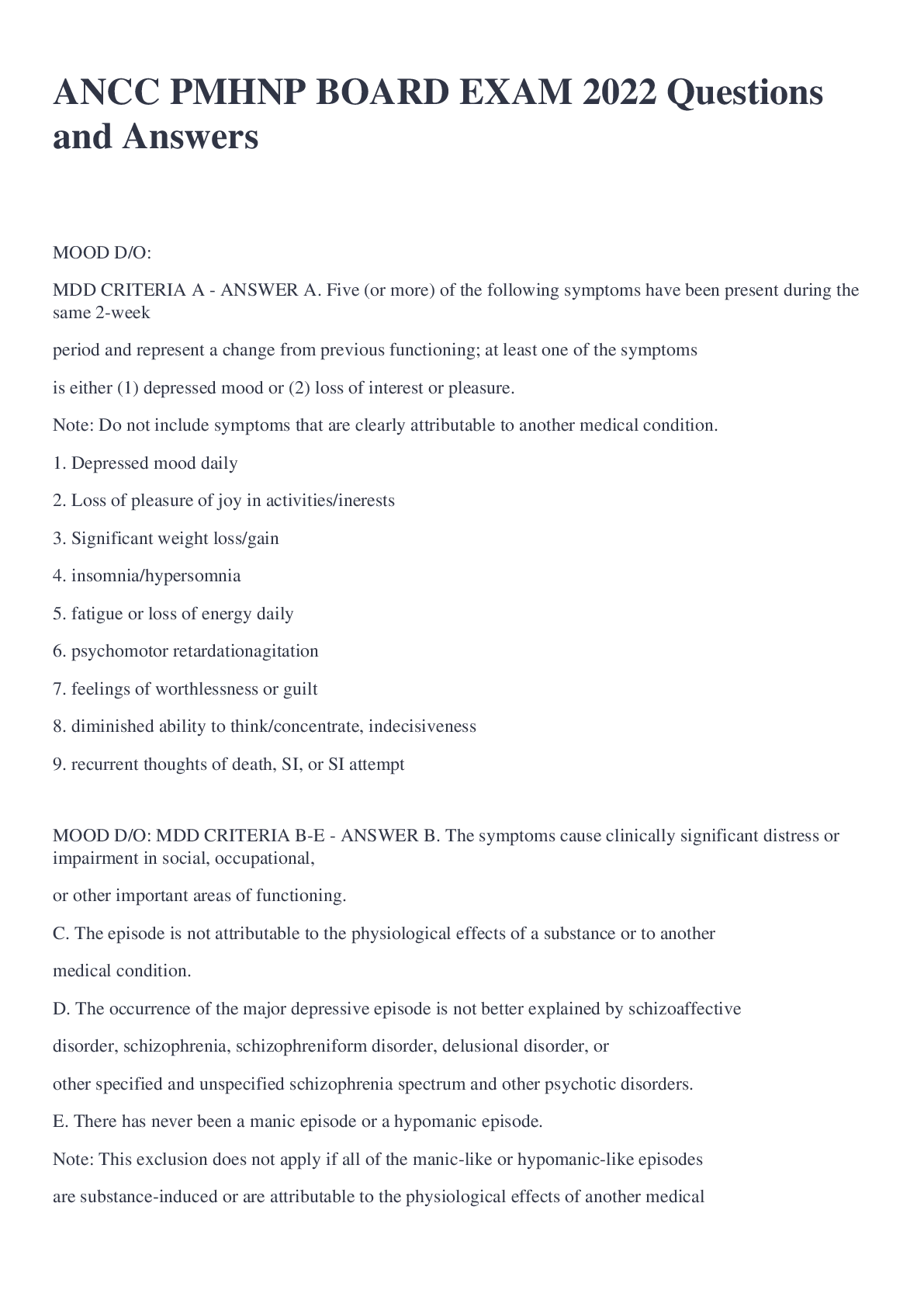
Buy this document to get the full access instantly
Instant Download Access after purchase
Buy NowInstant download
We Accept:

Reviews( 0 )
$8.00
Can't find what you want? Try our AI powered Search
Document information
Connected school, study & course
About the document
Uploaded On
Aug 16, 2022
Number of pages
24
Written in
All
Additional information
This document has been written for:
Uploaded
Aug 16, 2022
Downloads
0
Views
97

